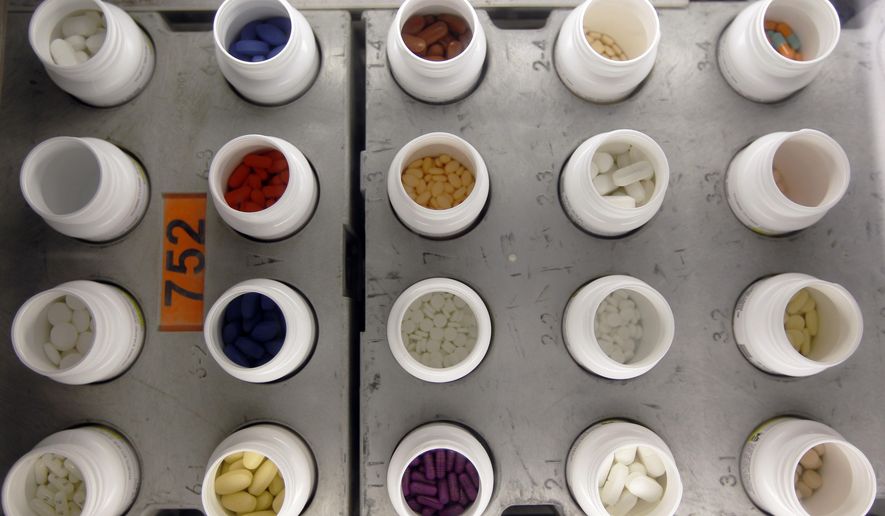OPINION:
There may be precious few legislative areas where bipartisan consensus can be achieved: Congress and the White House need to find a way to reopen the government, infrastructure is most often mentioned as an area of potential agreement, and reducing drug prices through legislative action is a shared goal of congressional Democrats and President Trump.
But there is another area where bipartisan action is possible and would be productive.
The innovation that creates the drugs of the future and is the pharmaceutical industry’s bedrock is at risk. This innovation does not occur without significant investment in research, sometimes decades in the making. A 2014 article in Scientific American cited the cost to bring a drug to market was $2.6 billion — and that was four years ago. These investments cannot be justified if drugmakers cannot get patents on their lifesaving drugs.
However, Congress has needlessly injected uncertainty into the research, development and approval process.
Protection of intellectual property is an important incentive. The U.S. protects intellectual property by rewarding branded-drug manufacturers with patent exclusivity for a defined period after a new product, costing billions of dollars, is developed and approved. Once the patent expires, generic drugs come online and the process repeats itself.
However, we also value competition in our pharmaceutical markets to help keep prices in check. In the U.S., we traditionally have encouraged generic drugmakers to enter the marketplace with copycat drugs at cheaper prices once patents for branded drugs expire or are overturned.
Despite a successful law that struck this balance between innovation and generic competition, Congress has created additional confusing and expensive pathways to challenge pharmaceutical patents, leaving innovating drug companies facing multiple challenges to their patents, even after federal courts rule them valid.
This patchwork of patent challenge pathways creates unnecessary litigation costs and subjects branded drugmakers to double jeopardy, ultimately discouraging innovation and raising drug prices.
In 1984, Congress passed the Hatch-Waxman Act, which aimed to boost generic entry into the pharmaceutical market while simultaneously protecting the incentive for branded companies to innovate. It has been highly successful.
Hatch-Waxman protects innovation by offering patent extensions to compensate for FDA approval delays. It further protects innovation by allowing for five years of data exclusivity, prohibiting generic use of branded data in its generic drug application. It expedites the approval of certain generic drugs. Finally, it creates a pathway to challenge branded drug patents before they expire.
This system was fair to large pharmaceutical companies and to generic drugmakers.
The market share for generics has increased sharply since the law was enacted, from 19 percent in 1984 to 89 percent in 2015. At the same time, innovating drugmakers’ spending on R&D consistently increased during that same period, hitting $500 billion since 2000.
This twin success — rapid innovation increases with consumer cost savings — has enabled generics to save the health care system $1.7 trillion over the past decade. It should be lost on no one that patents for generic drugs are also protected by this law.
This is where the problem arrived.
In 2012, Congress passed the America Invents Act, which created a new pathway to challenge patents, called inter partes review, which was sold as making it easier to take on “patent trolls,” with specific focus on the technology sector.
But this tool was not limited to technology. Generic drugmakers quickly began using the inter partes review process to challenge legally approved and binding patents. It became a second pathway or a back door: Fail at the Patent and Trade Office or in court initially, but then use the inter partes review process.
Unlike the Hatch-Waxman pathway, the inter partes review process favors the patent challenger.
This does not mean the entire inter partes review process should be repealed. It can and has been effective in addressing the plague of patent trolls in other industries. But in inter partes review, the deck is stacked in favor of the patent challenger, with lower evidentiary standards, lower costs, an easier filing system and a hearing before a patent review panel rather than a federal district court judge. Branded drug companies also face the real prospect of “double jeopardy,” having to win a case twice.
In the previous Congress, outgoing Senate Finance Committee Chairman Orrin G. Hatch, Utah Republican, and Rep. Bill Flores, Texas Republican and a senior member of the House Energy and Commerce Committee, filed legislation to end double jeopardy in pharmaceutical challenges.
Their legislation requires generic patent challengers to choose one pathway for challenging a drug patent: either Hatch-Waxman or inter partes review. The choice is entirely theirs; the bill would merely end the practice of using both pathways.
Congress should pass a similar common-sense measure to restore some predictability for innovators. Our lives depend on the results of their innovations.
• Matt Mackowiak is president of Austin, Texas, and Washington, D.C.-based Potomac Strategy Group. He is a Republican consultant, a Bush administration and Bush-Cheney re-election campaign veteran, and a former press secretary to two U.S. senators.




Please read our comment policy before commenting.